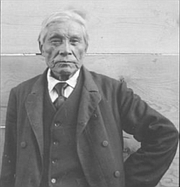Treaty Rock: What happened?
No treaty was signed there. No handshake or other customary method of sealing a deal was performed here. So, what’s the big deal? Here is the story.
Fredrick Post was born in Germany in 1821. He married at age 26 and a year later, in 1848, he immigrated from Germany to the U.S. with his new wife, Anna Margaret Hild, settling in Illinois.
Not only was Post industrious, he was inventive. He invented a riding scraper and a pulverizing land-roller plus dammed up two local creeks while in Illinois. In one creek he constructed a grist mill and in the other a lumber mill. As if that wasn’t enough, he operated a limestone quarry and built a dam across the Fox River. Still, he had the time to raise five daughters with Anna.
If Post had a genius it was in his understanding of the power inherent in flowing water. He moved to the Inland Northwest in 1871, and soon had business interests in Spokane and Rathdrum. But, more importantly, there was a waterfall nearby on the Spokane River, which, I hesitate to mention, made his mouth water.
Sometime in 1871 Post approached the person then in control of 200 acres on both sides of the Spokane River where “Little Falls” was located. (Little Falls was below Spokane Falls.) This man was a Coeur d’Alene Tribal Leader by the name of Chief Andrew Seltice. He had many cattle and a lot of land. He was known as a wise, gracious man who was interested in progress for his people.
On June 1, 1871, Post and Chief Seltice, as a representative of the Coeur d’Alene Tribe, wrote an agreement giving Post permission to use 200 acres on both sides of Little Falls. Post paid $500. The only “written” evidence of this transaction as seen in the pictographs celebrating this transaction on the rockface of Treaty Rock, now protected with plexiglass.
Post then did what would become a game changer for the entire inland north. He built a dam on the site which soon became the first source of dependable electric power. He built a sawmill which provided lumber to the local area and a grist mill. He started a town which was aptly named Post Falls.
The Museum of North Idaho continues to work diligently to “Move History Forward.” Soon the original verandas will be replaced on the centerpiece of the museum, the J.C. White house. The Coeur d’Alene City Council continues to work collaboratively with the museum to make sure all is done to ensure safety and is “up to code.”
— Richard Sheldon



